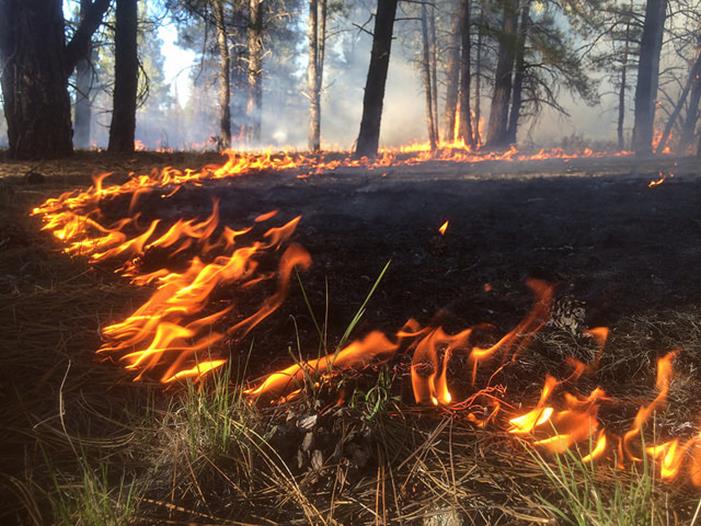Sitgreaves Complex Reaches Final Size; Improves Forest Health, Wildlife Habitat and Community Safety
September 23, 2014
WILLIAMS, Ariz. – The Sitgreaves Complex on the Williams Ranger District near Parks, Ariz., reached its final size of 11,080 acres earlier this month, improving overall forest health, wildlife habitat and community safety in an area that hadn’t seen significant fire in close to a century. 
The lightning-caused Duck Fire was originally discovered July 7 about 3 miles northwest of Parks, and fire managers decided to allow it to continue burning as it would naturally as long as it could be safely managed while benefiting forest resources. Soon after on July 13, lightning also sparked the Sitgreaves Fire just a few miles away from Duck, and a large planning area was established in which the fires could safely grow while achieving objectives such as clearing out understory brush and small trees and reducing the likelihood of high-severity fires that could threaten public and fire fighter safety during future fire seasons.
Over the next several weeks, the fires expanded rapidly when conditions were dry and slowed to a near standstill at other times when monsoon activity picked up, resulting in a mosaic of fire effects on the landscape and mimicking the historical progression of natural fire in a fire-adapted ecosystem.
The result of that kind of growth, according to preliminary assessments, was a fire that burned almost entirely at very low, low and moderate levels of severity. In fact, initial estimates indicate that only 53 of the 11,080 acres burned at a high level of severity.
Even those few areas that burned at a higher severity offer some benefit to forest resources, according to silviculturist Richard Gonzalez. “The areas with tree scorch and higher tree mortality provide vegetation communities with a mosaic of forest conditions,” Gonzalez said. “These conditions promote diversity of tree age and size classes; wildlife habitat components such as downed logs, snags, and openings in the tree canopy; and, the growth of aspen because of reduced conifer competition and increased sunlight to fire-stimulated saplings.”
Not only was the vast majority of the area treated with low-to-moderate severity fire resulting in many forest health benefits, but it was also done at a fraction of the average cost per acre of suppressing wildfires. The Sitgreaves Complex cost about $55 per acre to manage and resulted in a landscape that will be more resilient to future fires, even those that start during fire season when conditions are ripe for high-severity, destructive blazes.
“We have fire starts on Sitgreaves Mountain every year, and we have always been concerned that at the wrong time and under the wrong conditions, the effects could be devastating not only to the forest itself but also to residents in the area,” said James Pettit, fire management officer for the Williams Ranger District. “We had the opportunity to make a
difference in the long-term sustainability of forest conditions on the mountain by deciding to manage these fires, and we are very pleased with the results.”
Over the coming weeks, months and years, forest managers will continue monitoring the area and assessing the effects of the Sitgreaves Complex on the landscape. Including the Sitgreaves Complex, the Kaibab National Forest treated almost 29,000 acres with wildland fire managed for resource benefit during the monsoon season.
“What I’m most proud of is that we were able to improve safety for the people who live in Parks,” said Williams District Ranger Danelle D. Harrison. “Wildfire is a major threat in our area, and the local residents understood that and supported us in our decision to manage these fires. The result is that the mountain and the community are in better shape to withstand future fires.”


